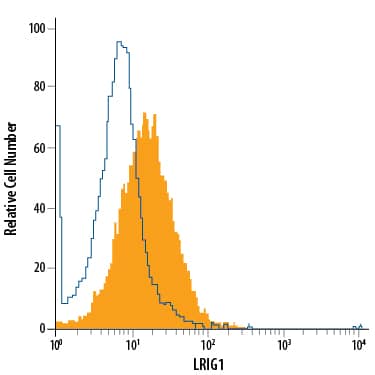Mouse LRIG1 PE-conjugated Antibody
R&D Systems, part of Bio-Techne | Catalog # FAB3688P


Key Product Details
Species Reactivity
Validated:
Cited:
Applications
Validated:
Cited:
Label
Antibody Source
Product Specifications
Immunogen
Ala37-Thr794
Accession # P70193
Specificity
Clonality
Host
Isotype
Scientific Data Images for Mouse LRIG1 PE-conjugated Antibody
Detection of LRIG1 in D3 Mouse Cell Line by Flow Cytometry.
D3 mouse embryonic stem cell line was stained with Goat Anti-Mouse LRIG1 PE-conjugated Antigen Affinity-purified Polyclonal Antibody (Catalog # FAB3688P, filled histogram) or isotype control antibody (Catalog # IC108P, open histogram). View our protocol for Staining Membrane-associated Proteins.Applications for Mouse LRIG1 PE-conjugated Antibody
Flow Cytometry
Sample: D3 mouse embryonic stem cell line
Formulation, Preparation, and Storage
Purification
Formulation
Shipping
Stability & Storage
- 12 months from date of receipt, 2 to 8 °C as supplied.
Background: LRIG1
LRIG1 (leucine-rich repeats and Ig-like domains-1; also LIG-1) is an approximately 130-145 kDa glycoprotein that belongs to the LRIG gene family. It is widely expressed, and appears on the surface of prostatic epithelium, endothelial cells, vascular and visceral smooth muscle, mammary epithelium, cardiac muscle, keratinocytes and neurons. LRIG1 is believed to negatively regulate the ErbB family of receptors. In particular, and in a ligand-independent manner, LRIG1 complexes with all four ErbBs, promoting their ubiquitination and decreasing their number. Alternatively, LRIG1 is suggested to bind to the ErbBs, preventing their dimerization and signal transduction. Mature mouse LRIG1 is a 1057 amino acid (aa) type I transmembrane protein. It contains a large 762 amino acid (aa) extracellular domain (ECD) (aa 35-795) plus a 274 aa cytoplasmic region. The ECD contains 17 LRRs (aa’s 35-491) and three C2-type Ig-like domains (aa’s 497-781). These two domain types are each sufficient for EGFR binding. There one potential alternative splice form that a deletion of aa 875-923. The LRIG1 ECD undergoes proteolysis, generating 90-105 and 60-70 kDa soluble fragments. Over aa 37-794, human LRIG1 shares 97% and 90% aa sequence identity with rat and human LRIG1, respectively.
Long Name
Alternate Names
Gene Symbol
UniProt
Additional LRIG1 Products
Product Documents for Mouse LRIG1 PE-conjugated Antibody
Product Specific Notices for Mouse LRIG1 PE-conjugated Antibody
For research use only